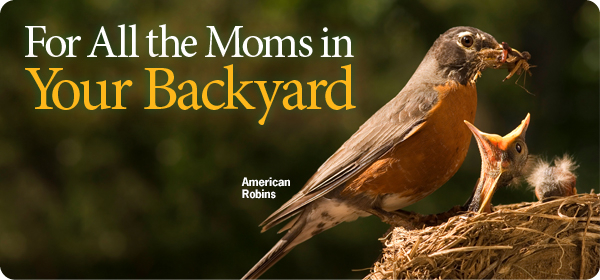Welcome, Vancouver!
Please Note: We will be CLOSED on Monday, May 20th for Victoria Day!

Let's Celebrate Moms!
It's The Perfect Time to Find The Perfect Gift
Save 20% on all Hummingbird Feeders!*
*Valid in-store at WBU Vancouver and North Vancouver and online. One discount per purchase. Offer not valid on previous purchases, when combined with other offers, or on sale items. Offer valid only from May 4th 2024 to May 12th 2024.
All About Bird Moms
Bird moms come in all shapes, sizes and colors. Here are some of the most fascinating behaviors from around the world of mother birds.
- Most Talented Mom - It takes as many as 12 days for a female Oriole to weave her nest. One Baltimore Oriole was observed spending 40 hours interlacing her basket-like nest. It included over 10,000 stitches and thousands of knots, all done by mom’s talented beak.
- Most Loyal Mom - A pair bond may form between a male and a female Carolina Wren at any time of the year. She will stay with him for life, always foraging and moving around within sight of her mate.
- Quickest Mom - Black-capped Chickadees have one of the shortest incubation periods of all birds. Their eggs can hatch in as little as 11 days.
- Trickiest Mom - By singing a "male" song, the female Black-headed Grosbeak can trick her mate into thinking a rival male is nearby, forcing him to stay close to the nest.
- Supersized Mom - Sharp-shinned Hawk females average over 40% larger than their male counterparts. This size difference is the largest of all of North American birds of prey.
- Mini-Mom - A mother hummingbird weighs only about eight times more than the eggs she lays.
- Most Overworked Mom - Mourning Dove moms may raise up to six broods per year, more than any other native North American bird.
- Most Laid-back Mom - Unlike most other bird moms, robins do not lay their eggs at sunrise. They lay their eggs several hours later during the mid-morning. Since earthworms are easier to find during early morning, they feed first and then return to the nest to lay their eggs.
- Most Devoted to Mom - Young Tufted Titmice often remain with their parents throughout their first winter. They have been known stay with mom into the next nesting season and help her to raise the next brood.
- One Cold & Small Mom - The Rufous Hummingbird nests in Alaska!
- The Last Mom - American Goldfinch moms are one of the last songbirds to nest each year, waiting until mid-to-late summer when thistle seeds and down are readily available.
Stop by the store today and ask our Certified Birdfeeding Specialists which foods and feeders are best for bird moms this season!

Backyard Habitat – You Can Make a Difference!
Think of your yard as a blank slate. If you could start from scratch, what would be your ultimate landscape design? A classical French garden? An English cottage garden? Or the tried and true suburban turf grass and shrubbery design? While all of these designs can bring style and beauty to your yard, if your desire is to invite lots of birds and other wildlife to be a part of your outside home you might be disappointed!
Designing your garden purely for style without taking into consideration its place in your local ecosystem is a recipe for failure if your goal is a place attractive to wildlife. So, why not consider a different garden design…a habitat garden! Habitat gardens display all of the beauty and style as the other designs, but they also attract and nurture a much broader variety of wildlife such as bees, butterflies, birds, and amphibians.
By creating a native landscape that provides wildlife with food, water, shelter and the places they need to raise their young, you will also play a valuable role in helping to reverse some disturbing trends in wildlife populations.
Research has recently quantified the loss of almost one-third of our total bird population in North America over the last 50 years, and our Monarch Butterfly population has declined by more than 80 percent since the mid-1990s. Scientists have identified habitat loss as the biggest reason for these and other wildlife declines.
Just imagine if we could re-make every suburban lawn in North America into a nurturing wildlife habitat! While once a daunting thought, it is easier and more realistic to do than ever before thanks to Birds Canada’s Gardening for Birds program. Through the use of Birds Canada’s abundant support materials and online resources, everyone can be inspired to create a haven for wildlife in their own yard!
Wild Birds Unlimited is proud to support the Gardening for Birds program and encourages everyone to plant a habitat garden for birds. Visit www.wbu.com/gardening-for-birds to see how easy it is to create your own backyard habitat and to truly make a difference for the future of song birds and other wildlife.


